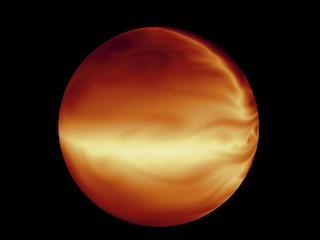The planet: HD 108236 b
The discovery: This scorchingly hot "super-Earth," more than 1 1/2 times as big around as our home planet, orbits a star very much like our Sun some 210 light-years away. It has a family of four sibling planets, all in tight, star-hugging orbits. But the embrace of HD 108236 b is the tightest, keeping this planet infernally hot.
Key facts: With a likely surface temperature of more than 1,500 Fahrenheit (825 Celsius), this planet has no chance of being habitable. The same is probably the case for the other four planets detected in this system, all possible "mini-Neptunes," or gaseous worlds that are smaller versions of our Neptune. But scientists who study exoplanets – planets around other stars – are excited about this system nevertheless. It offers the chance to help solve a major mystery of how planetary systems form, and how some rocky worlds – those that otherwise might have been something like Earth – are instead condemned to broil.
Details: This planetary system seems almost perfectly poised for scientific investigation. The star, similar to our Sun, is bright and reasonably close (at least by astronomical standards).
Space telescopes, including NASA's James Webb Space Telescope, which launched late in 2021, can capture starlight shining through the atmospheres of these mini-Neptunes as they cross the face of their star. With such a star, of just the right brightness, that potentially would yield a clear "readout" of the gases that dominate planetary atmospheres – in other words, a snapshot of the molecules and chemistry in the skies of distant worlds.
The brightly shining system also could shed light on a scientific puzzle that has emerged over a quarter century of exoplanet hunting. Between two planetary size-ranges, "super-Earths" and mini-Neptunes, is a gap – very few planets. The hot super-Earth in this system, HD 108236 b, is among the few found so far that seems to fall just within the gap; its larger sister planets fall outside it. Among the theories about why this occurs is the idea of photo-evaporation, when intense radiation from a star strips away the atmosphere of, say, a mini-Neptune that wanders too close. That could potentially leave behind a broiling, rocky hulk – no longer mini-Neptune-sized, and instead kicked to the smaller side of the "radius gap." Scientists, helped by this bright star, will investigate whether HD 108236 b is just such a planet.
Fun facts: While none of the five planets found so far in this system is likely to be habitable, other planets in more distant orbits might be discovered in the future. A rocky planet at an orbital distance comparable to Earth's – and so potentially habitable – is not out of the question. That would qualify as an Earth-Sun analog, which has so far eluded exoplanet hunters.
The discoverers: An international team led by astrophysicist Tansu Daylan of MIT used data from TESS (the Transiting Exoplanet Survey Satellite) taken in 2019 to reveal this system's super-Earth and three of its mini-Neptunes. A second team using the European CHEOPS (CHaracterising ExOPlanet Satellite) space telescope confirmed these planets and discovered a fifth, also a possible mini-Neptune.











